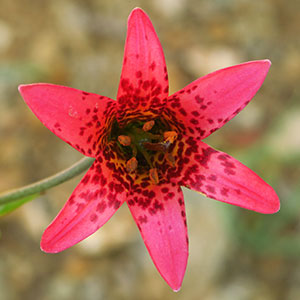Lilium bolanderi
Lilium kelloggii
Bolander's lily
Kellogg's lily
± ovoid, 3.5–7.9 × 2.6–5.3 cm, 0.9–2.1 times taller than long;
scales unsegmented, longest 3–5.7 cm;
stem roots absent.
± ovoid, 3.6–7.5 × 2–5.2 cm, 0.9–2.4(–2.7) times taller than long;
scales unsegmented, longest 3.1–6.4 cm;
stem roots absent.
to 1.1 m, glaucous.
to 2.1 m. Buds rounded in cross section.
rounded in cross section.
in 1–5(–6) whorls or partial whorls, 3–19 leaves per whorl, ascending and often cupping stem, 1.8–7.1 × 0.7–2.8 cm, 2.2–4.8 times longer than wide;
blade ± obovate, oblanceolate, or occasionally elliptic, noticeably glaucous, margins nearly always undulate, apex widely acute;
veins and margins ± smooth abaxially.
in 2–7 whorls or partial whorls (scattered and ± proximal in dry, exposed sites), 3–22(–40) leaves per whorl, drooping at tips to ascending, 6–16 × 0.9–4.4 cm, 2.6–8.5 times longer than wide;
blade elliptic, usually narrowly so, often weakly oblanceolate, rarely obovate, margins undulate or not, apex acute;
veins and margins ± smooth abaxially.
usually umbellate in small plants, in large plants racemose or in 2 whorls, 1–9-flowered.
racemose, 1–27-flowered.
nodding to horizontal, not fragrant;
perianth ± campanulate or funnelform;
sepals and petals somewhat recurved 3/5–4/5 along length from base, red or magenta, occasionally salmon pink or pale yellow, with maroon spots, often yellowish on proximal 1/3–1/2, not distinctly clawed;
sepals not ridged abaxially, 3.1–4.7 × 0.7–1.2 cm;
petals 3–4.5 × 0.7–1.1 cm;
stamens included;
filaments barely spreading, diverging 0°–12° from axis;
anthers reddish or magenta, 0.3–0.8 cm;
pollen rust, orange, or yellow;
pistil 2.1–3.5 cm;
ovary 1–2.1 cm;
style green, rarely reddish purple;
pedicel 0.8–14.2 cm.
pendent, fragrant;
perianth Turk’s-cap-shaped;
sepals and petals reflexed 1/3 along length from base, pink, less often white, and if so usually aging pink, usually with copious maroon spots and proximal median longitudinal yellow stripe extending from basal nectaries, not distinctly clawed;
sepals darker pink abaxially and usually distally, not ridged abaxially, 3.4–7.2 × 0.9–1.7 cm;
petals 3.2–7.1 × 0.9–1.9 cm;
stamens moderately exserted;
filaments ± widely spreading, diverging 10°–22° from axis;
anthers pale red-orange or magenta, 0.5–1.4 cm;
pollen orange;
pistil 2.9–4.2 cm;
ovary 1.5–3 cm;
style green, often pale;
pedicel 8.8–23.8 cm.
2–4.1 × 1.2–2.1 cm, 1.4–3 times longer than wide.
2.9–5.7 × 1–1.6 cm, 2.2–3.7 times longer than wide.
90–210.
177–309.
= 24.
= 24.
Lilium bolanderi
Lilium kelloggii
I. M. Johnston (1923) noted that Lilium bolanderi Watson was based on a mixed collection including L. kelloggii, and he argued that Watson intended the name to apply primarily to the latter species. Thus he proposed the name L. howellii for this diminutive, red-flowered, serpentine endemic. A. D. Cotton (1936) correctly concluded that Watson’s description applied primarily to the specimens here called L. bolanderi, and this view is now widely accepted.
Lilium bolanderi hybridizes with L. rubescens, L. washingtonianum subsp. purpurascens, and subspecies of L. pardalinum.
Bolander’s lily is primarily pollinated by Allen’s and rufous hummingbirds (Selasphorus spp., family Trochilidae).
(Discussion copyrighted by Flora of North America; reprinted with permission.)
Kellogg’s lily occurs from Humboldt County, California, north to just over the Oregon border. Like Lilium bolanderi and L. pardalinum subspp. vollmeri and wigginsii, it is endemic to the Klamath Mountains.
Occasionally plants occur with one or more whorls coalesced into tufts with as many as 40 leaves. Plants in open chaparral are usually of small stature with compact inflorescences and the ascending leaves are undulate on the margins. Plants of forest gaps are larger, with open inflorescences and flat, horizontal leaves.
Lilium kelloggii is pollinated by pale swallowtail butterflies (Papilio eurymedon Lucas, family Papilionidae) and western tiger swallowtails (P. rutulus Lucas).
(Discussion copyrighted by Flora of North America; reprinted with permission.)


